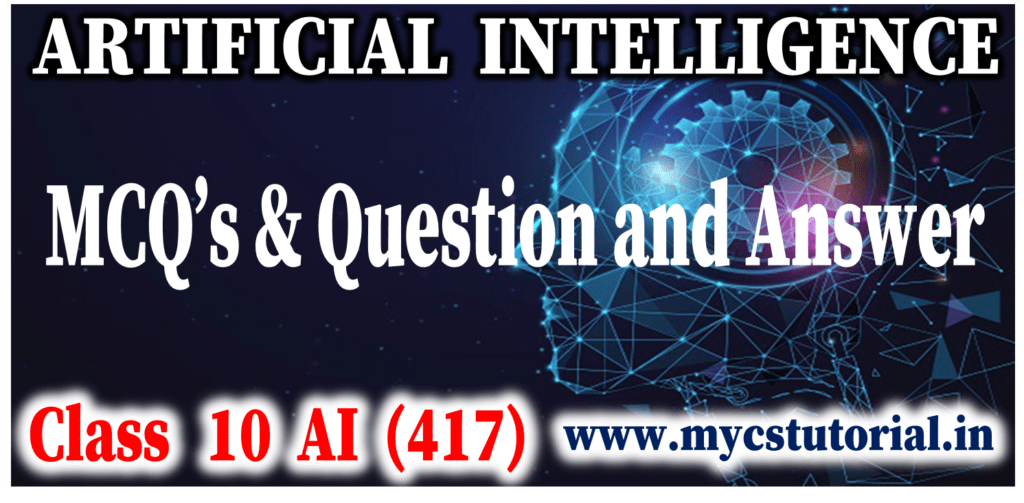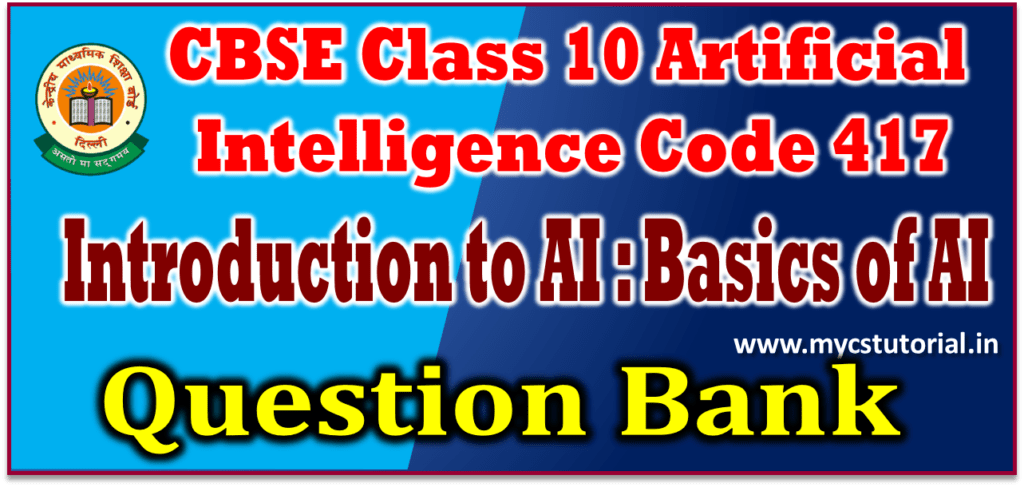By Anjeev Kr Singh – Computer Science Educator
Published on : September 18, 2022 | Updated on : February 9, 2023
CBSE Question Bank – AI – Class 10 – Chapter 1 Introduction to AI : Foundational Concepts
Que 16. Explain how AI works in the following areas (any two):
a. Google Search Engine
b. Voice Assistants
c. E-commerce websites
Answer:
a. Google Search Engine: With the help of AI, Google Search Engine has been turned into Intelligent search which is a new network of systems that produces direct answers. It uses voice and image searches and has incorporated deep learning to fasten the searches with more accuracy.
b. Voice assistant: AI is being used in voice assistants to recognize words spoken by the user. NLP has capabilities like “Speech-to-Text” convert the natural language of the user into text for
further processing. As the digital assistant answers more and more queries, it “learns” using ML algorithms. The more tasks it performs, its ML algorithms help it “learn” from the tasks and the preferences of the user. As a result, the digital assistant improves its performance over time.
c. E-commerce website: With the use of big data, AI in E-Commerce is impacting customer choices by recording the data of previous purchases, searched products, and online browsing habits. Product recommendations provide multiple benefits for E-commerce retailers including: Higher number of returning customers.
Que 17. How has AI changed the gaming world?
Answer: AI has changed the world of gaming by making the game more intelligent by providing
them the ability to learn using machine learning algorithms. Games these days try to
understand human patterns and give responses on the basis of it and also give new
difficulty levels.
OR
AI has changed the gaming world in terms of feel and emotions. Some video games
react to player skill level. Depending on how well you do, adaptive AI ratchets the
game’s difficulty level up and down to give you a greater challenge when you need it or
to prevent you from rage-quitting in frustration. AI can also adapt to your playing style
by making the game more exciting.
Que 18. Why training with information/Data is important in Artificial Intelligent devices?
Answer: Similar to human beings, AI devices need experience to give better results and improve in every next iteration. For giving better results, the machine should be trained with some real data. The more the amount of accurate data, the better predictions will be made by the machine. Hence, data is very important in AI devices.
OR
The AI devices need to be trained with information / Big data to produce the best possible accurate results. All of AI’s learning happens only through this data. So, it makes sense to have as big a dataset as is required to include variety, subtlety, and nuance that makes the model viable for practical use. Before training, the model is just a theorist.
CBSE Question Bank – AI – Class 10 – Chapter 1 Introduction to AI : Foundational Concepts
4 Mark Questions
Que 19. What is Intelligence? Explain in brief any three types of intelligence that are mainly perceived by human beings?
Answer: Intelligence is the ‘ability to perceive or infer information, and to retain it as knowledge to be applied towards adaptive behavior within an environment or context.’
OR
Intelligence is the ability to interact with the world (speech, vision, motion, manipulation), ability to model the world and to reason about it, ability to learn, ability to make decisions and to adapt.
OR
Intelligence has been defined in many ways: It involves abstract reasoning, mental representation, problem solving, and decision making, the ability to learn, emotional knowledge, creativity, and adaptation to meet the demands of the environment effectively.
As per major researches, there are mainly 9 types of Intelligence;
(i) Mathematical Logical Intelligence: A person’s ability to regulate, measure, and understand numerical symbols, abstraction and logic.
(ii) Linguistic Intelligence: Language processing skills both in terms of understanding or implementation in writing or speech.
(iii) Spatial Visual Intelligence: It is defined as the ability to perceive the visual world and the relationship of one object to another.
(iv) Kinesthetic Intelligence: Ability that is related to how a person uses his limbs in a skilled manner.
(v) Musical Intelligence: As the name suggests, this intelligence is about a person’s ability to recognize and create sounds, rhythms, and sound patterns.
(vi) Intrapersonal Intelligence: Describes the level of self-awareness someone has starting from realizing weakness, strength, to recognizing his own feelings.
(vii) Existential Intelligence: An additional category of intelligence relating to religious andspiritual awareness.
(viii) Naturalist Intelligence: An additional category of intelligence relating to the ability to process information on the environment around us.
(ix) Interpersonal Intelligence: Interpersonal intelligence is the ability to communicate with others by understanding other people’s feelings and the influence of the person.
Que 20. Differentiate between what is AI and what is not AI with the help of an example?
Answer:
| AI Machine | Not AI machine |
| 1. AI machines are trained with data and algorithms. 2. AI machines learn from mistakes and experience. They try to improvise on their next iterations. 3. AI machines can analyses the situation and can take decisions accordingly. 4. AI based drones capture the real-time data during the flight, processes it in real-time, and makes a humanindependent decision based on the processed data. | 1. Smart machines which are not AI, do not require training data, they work on algorithms only. 2. Smart machines work on fixed algorithms and they always work with the same level of efficiency, which is programmed into them. 3. Machines which are not AI cannot take decisions on their own. 4. An automatic door in a shopping mall, seems to be AI-enabled, but it is built with only sensor technology. |
(Any other valid examples of AI and Non-AI machine can be considered.)
While we see a lot of AI applications around us, there still exist a lot of them which are smart but not intelligent.
An AI enabled machine should not only recognize, but should also do something with its gathered information. Artificial intelligence” must mean a human-made interface with the power to reason and integrate knowledge. AI must demonstrate at least some of the following behaviors associated with human intelligence: planning, learning, reasoning, problem solving, knowledge representation, perception, motion, manipulation and, to a lesser extent, social intelligence, and creativity.
Most IOT items are ordinary things outfitted with sensors and connected to the Internet. For example, sensors in your office can recognize shadows or movements, but that doesn’t make them an example of artificial intelligence. A fully automatic washing machine can work on its own, but it requires human intervention to select the
parameters of washing and to do the necessary preparation for it to function correctly before each wash, which makes it an example of automation, not AI.
Que 21. How can AI be integrated with non-AI technologies? Explain with the help of an example.
Answer: Today’s world is changing with the adoption of IOT (Internet of Things). IOT is helping in prominently capturing a tremendous amount of data from multiple sources. The convergence of AI (Artificial Intelligence) and IOT can redefine the way industries, business, and economies function. AI enabled IoT creates intelligent machines that simulate smart behavior and supports decision making with little or no human interference.
While IOT provides data, artificial intelligence acquires the power to unlock responses, offering both creativity and context to drive smart actions. Here are some examples:
Ex. 1: Self-driving Cars: Tesla’s self-driving cars are the best example of IoT and AI working together. With the power of AI, self-driving cars predict the behavior of pedestrians and cards in various circumstances. For example, they can determine road conditions, optimal speed, weather and getting smarter with each trip.
Ex. 2: Robots in Manufacturing: Manufacturing is one of the industries that already embraced new technologies like IoT, artificial intelligence, facial recognition, deep learning, Robots and many more. Robots employed in factories are turning smarter with the support of implanted sensors, which facilitates data transmission. Moreover, as the robots are provisioned with artificial intelligence algorithms, they can learn from newer data. This approach not only saves time and cost but also makes the manufacturing process better over time.
Ex.3: Weather forecasting System: In a weather forecasting system, where IOT temperature sensor and humidity sensors collect data from the physical world, AI tries to figure out patterns from previous data collected and tries to interpret
and give accurate predictions of upcoming day weather.
Ex.4: Smart Drones: Initially drones were only able to capture photographs, these were not AI drones. As the scientist used to analyze the data captured through drones. Now the drones are incorporated with AI, which helps them to make
decisions also on the basis of the picture they capture.
*Any one example from above or any other matching example can be given








